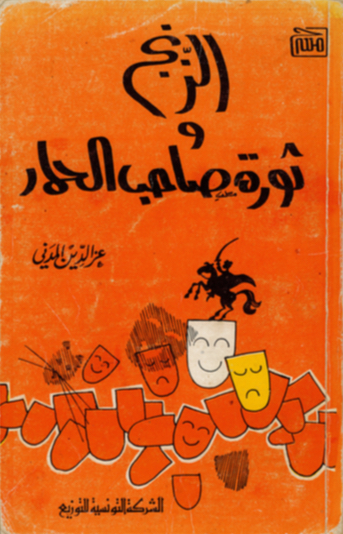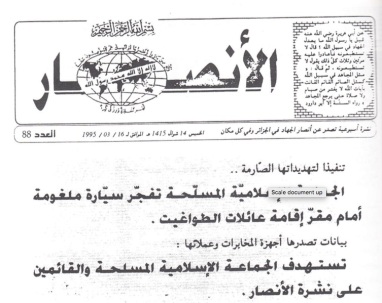
“al-Zanj wa-thawrat ṣāhib al-ḥimār” is a play by Tunisian writer ʿIzz al-Dīn al-Madanī (b.1938) that chronicles the story of Abū Yazīd. Since the Tunisian revolution in 2011, it has been a regular feature at festivals in Tunisia due to the play’s symbolic use of revolts against injustice. The cover to the printed edition (al-Sharika al-Tūnisiyya li-l-tawzīʿ, 1988) is shown here.
[تنبيه: الترجمة العربية ستأتي بعد]
Ibadis appear in surprising places—including late-20th century Jihadist literature. This post is about an unexpected use of the story of the famous 10th-century Ibadi leader of a rebellion against the Fatimid dynasty, Abū Yazīd Makhlad b. Kaydād (d.333/945), which appeared in a Jihadist newsletter from the 1990s called al-Anṣār. I learned about this passage from Wissam Hiti, a graduate student at Al Akhawayn University whose thesis uses this newsletter to examine discourses of violence in Algeria’s ‘Black Decade’ (1992-2002). I am delighted to have her as a coauthor here.
The GIA in Algeria and al-Anṣār [1]
In the 1960s, the Maghrib witnessed the rise of Islamism due to a multitude of social, economic and political factors, with the first outbursts taking place in the late 1970s. Some radical stances in the Islamist movements tried to exploit the ideas of Jihad to justify opposition to Maghribi states. This threat to the hegemony of the ruling elites led to a swift combination of co-optation and repression on Islamist tendencies, in general. While some adhered and even embraced the status quo, other Islamists chose the path of exile where they met other dissident and often, radical voices from the Mashriq in different places including Europe.

The front page of Majallat al-Anṣār 88 (30 March 1995), in which the article mentioning Abū Yazīd appears.
London became one of the havens of Jihadists, particularly after the end of the Soviet-Afghan War (1979-89). By the 1990s, the city emerged as a major print and distribution hub for media outlets in Arabic. One of these newsletters was al-Anṣār, to which two key figures in the Jihadi scholarship regularly contributed from 1994 to 1996: Abū Qatāda al-Filasṭīnī and Abū Musʿab al-Sūrī. While the former embraced a rigid Salafi orientation and was more of a preacher and doctrinarian, the latter had a pragmatic outlook and military orientation probably due to his active engagement as a mujāhid in the Afghanistan War.
The newsletter dubbed itself as the voice of the GIA (Armed Islamic Group) in Algeria, whose members participated in the massive bloodshed in the country throughout the 1990s. Al-Anṣār was mainly funded and supported by Al-Qaeda. It became a space where the two major contributors mentioned above devoted attention to clarifying key points of Salafi-jihadi doctrine such as rejecting an Islamism that willingly engages in non-violent politics, insisting on a Salafi creed while by the same means rejecting non-Jihadi Salafism, and accusing of unbelief Arab rulers and their supporters. [2]
Abū Qatāda al-Filasṭīnī contributed to a weekly section entitled Bayna manhajayn under the section Min ṣamīm al-manhaj. This specific contribution of his would later be compiled in a booklet entitled al-Jihād wa-l-ijtihād and made available on the Al-Qaeda online library, Minbar al-jihād wa-l-tawḥid, marking it as essential reading for Jihadi activists. [3]
Abū Yazīd, the Jihadist
The story of Abū Yazīd appears in this same section, Min ṣamīm al-manhaj, where the author is discussing the Fatimids, whom he refers to as al-ismāʿīliyyūn al-ʿubaydiyyūn. The specific passage mentioning Abu Yazid reads:
“The shining minds of Islam in the Maghrib, including extraordinary Maliki scholars, rose up and fought [the Fatimids] without hesitation. When Abū Yazīd the Kharijite (who was of the Ibadi madhhab) began his rebellion, some people hesitated to fight the apostates [i.e., the Fatimids] under the banner of the Kharijites. But the argument of the [Maliki] scholar Imams at that time was: “We fight under the flag of whomever believes in God against the flag of whomever disbelieves. Yes, we fight under the banner of the Kharijites against the miscreant apostates!” And so, the brilliant Imam, the serpent of the valley, Rabīʿ al-Qaṭṭān donned the Qur’ān (lit. al-muṣḥaf) around his neck, went out [to battle with Abū Yazīd], and fought the apostates until he was martyred.” [4]
That is probably the most generous historical account of Abū Yazīd’s rebellion out there. First of all, the account is unusual in its (relatively) positive portrayal of Abū Yazīd. It probably won’t come as a surprise that the Fatimid historians were not big fans of Abū Yazīd but even the later Ibadi tradition distanced itself from him. He was given the moniker ‘al-Nukkārī’ (the denier) in an attempt to associated him with a branch of Ibadis who (unsuccessfully) challenged the dominant narrative of Ibadi history. Since Ibadis are ambivalent and the Fatimids sometimes referred to Abū Yazīd as the ‘anti-Christ’ (al-dajjāl), it is fascinating how the author of this article has recast his story and made him the champion of rebellion even for his Maliki contemporaries. At the end, he even points out that the famous Maliki scholar and ascetic, Rabīʿ al-Qaṭṭān, fought alongside Abū Yazīd in the battle of Wādī Māliḥ, where he was martyred. [5]
So, there you have it: Abū Yazīd, the Jihadist.
—
Notes
[1] This section was authored by Wissam Hiti, based in part on her thesis research, tentatively entitled: Memorable violence: Algeria’s Black Decade and the Social Structure of the Past (1992-2002).
[2] Thurston, Alexander. “Algeria’s GIA: The First Major Armed Group to Fully Subordinate Jihadism to Salafism.” Islamic Law and Society 24: 4 (2017): 422. https://doi.org/10.1163/15685195-00244P05.
[3] See: http://www.ilmway.com/site/maqdis/MS_150.html
[4] Abū Qatāba al-Filasṭīnī. “Bayna manhajayn,” Majallat al-Anṣār 88 (30 March 1995): 5-6. (Accessed on 25/10/2017 at: https://archive.org/details/ansar_masg)
[5] For a full historical and historiographical overview, see Chapoutot-Remadi, Mounira, “Abū Yazīd al-Nukkārī”, in: Encyclopaedia of Islam, THREE, Edited by: Kate Fleet, Gudrun Krämer, Denis Matringe, John Nawas, Everett Rowson. (Consulted online on 02 January 2018) http://dx.doi.org/10.1163/1573-3912_ei3_COM_23783 [First published online: 2013; First print edition: 9789004252653, 2013, 2013-1]